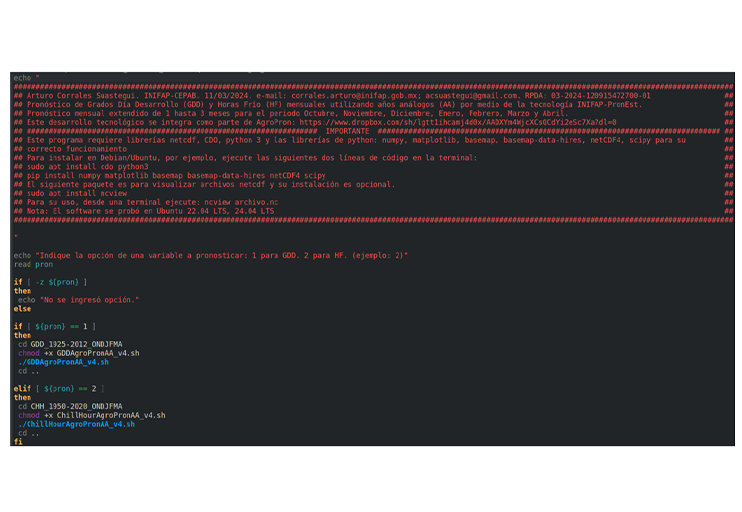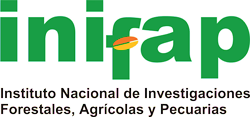Statistical forecast of GDDs and CHs for northern Mexico improved for bias correction
DOI:
https://doi.org/10.29312/remexca.v16i30.4048Keywords:
analogous years, bias correction, growing degree-days, chilling hoursAbstract
The existing information on monthly climate forecasts of agrometeorological variables, such as growing degree-days and chilling hours, is limited. This work presented the evaluation of a statistical forecast of growing degree-days and chilling hours for northern Mexico, with a focus on grape- and pecan-producing regions. The forecasting model is based on the analogous years method, using sea surface temperature anomalies through the monthly Niño-3.4 index, which is based on the ERSSTv5 database. In addition, it uses monthly historical databases of growing degrees-days and chilling hours, corresponding to the periods 1925-2012 and 1950-2020, respectively. To evaluate the model, monthly retrospective forecasts of growing degree-days and chilling hours were made for a period of 12 years (2012-2023) and contrasted with observations. It was found that the model underestimated up to -100 growing degree-days for regions in the south and center of the country; in contrast, for Sonora, Chihuahua, Durango, and Coahuila, the growing degree-days were underestimated with values ranging from -20 to -60 growing degree-days. In the case of chilling hours, it was found that the model underestimated up to 60 chilling hours, mainly in Chihuahua, Durango, Zacatecas, Baja California, and the center of the country. Based on these results, a bias correction method was applied, which was based on subtracting the mean bias, to reduce the error in the forecast. The corrected model showed a reduction in bias, mainly in cold months. Nevertheless, persistent bias was found in the model after applying bias correction.
Downloads
References
Anghileri, D.; Monhart, S.; Zhou, C.; Bogner, K.; Castelletti, A.; Burlando, P. and Zappa, M. 2019. The value of subseasonal hydrometeorological forecasts to hydropower operations: how much does preprocessing matter? Water Resour. Res. 55(12):10159-10178. https://doi.org/10.1029/2019WR025280.
Baskerville, G. L. and Emin, P. 1969. Rapid estimation of heat accumulation from maximum and minimum temperatures. Ecology. 50(3):514-517.
Campoy, J. A.; Ruiz, D. and Egea, J. 2011. Dormancy in temperate fruit trees in a global warming context: a review. Scientia Horticulturae. 130(2):357-372. https://doi.org/10.1016/j.scienta.2011.07.011
Chandler, W. H. 1942. Deciduous orchards. Lea and Febiger, Philadelphia. 438 p.
Chhetri, A.; Ramjan, M. D. and Dolley, N. 2018. Various models of calculating of chill units in fruits crops. Indian Farmer. 5(04):439-442.
Corrales-Suastegui, A.; Martínez-Diaz, G.; Ruiz-Álvarez, O.; González- González, M. A. and Pavía, E. G. 2022. Temperature and precipitation towards the ed of the 21st Century in pecan producing areas of Mexico. Advanced Modelling and Innovations in Water Resources Engineering. 235-254 pp. Singapore: Springer. https://doi.org/10.1007/978-981-16-4629-4-18.
Corrales-Suastegui, A.; Ruiz-Alvarez, O.; Torres-Alavez, J. A. and Pavia, E. G. 2021. analysis of cooling and heating degree days over Mexico in present and future climate. Atmosphere. 12(9):1131. https://doi.org/10.3390/atmos12091131.
Corrales-Suastegui, A.; González-Jasso, L. A.; Narváez-Mendoza. M. P.; González González, M. A.; Ruíz-Álvarez, O. y Maciel-Pérez, L. H. 2014. PronEst: aplicación informática para generar pronósticos estacionales de lluvias y heladas de uno a tres meses. INIFAP-CIRNOC-CEPAB. Folleto técnico núm. 62. 21 p.
Flores-Gallardo, H.; Ojeda, W.; Flores, H.; Mejía-Sáenz, E. e Ibarra, E. 2012. Grados día y la programación integral del riego en el cultivo de papa. Terra Latinoamericana. 30(1):59-67.
INEGI. 2020. http://cuentame.inegi.org.mx/monografias/default.aspx?tema=me.
Jha, P. K. and Pathak, T. B. Seasonal climate forecasts show skill in predicting winter chill for specialty crops in California. Commun Earth Environ. 5:485. https://doi.org/10.1038/s43247-024-01623-0.
Liu, J. and Sherif, S. M. 2019. Combating spring frost with ethylene. Frontiers in Plant Science. 10:1408. https://doi.org/10.3389/fpls.2019.01408.
Livneh, B.; Bohn, T. J. and Pierce, D. W. 2015. A spatially comprehensive, hydrometeorological dataset for Mexico, the US. and Southern Canada 1950-2013. Sci. Data. 2:150042. https://doi.org/10.1038/sdata.2015.42.
Lorenz, C.; Portele, T. C.; Laux, P. and Kunstmann, H. 2021. Bias corrected and spatially disaggregated seasonal forecasts: a long-term reference forecast product for the water sector in semi-arid regions. Earth System Science Data. 13(6):2701-2722.
Luedeling, E. 2012. Climate change impacts on winter chill for temperate fruit and nut production: a review. Scientia Horticulturae. 144:218-229.
Luedeling, E. and Brown, P. H. 2011. A global analysis of the comparability of winter chill models for fruit and nut trees. International Journal of Biometeorology. 55:411-421. 10.1007/s00484-010-0352-y.
Luedeling, E., Girvetz, E. H., Semenov, M. A. and Brown, P. H. 2011. Climate change affects winter chill for temperate fruit and nut trees. PLoS One. 6(5):e20155. https://doi.org/10.1371/journal.pone.0020155.
McMaster, G. S. and Wilhelm, W. W. 1997. Growing degree-days: one equation, two interpretations. Agricultural and Forest Meteorology. 87(4):291-300.
Muñoz-Sabater, J.; Dutra, E.; Agustí-Panareda, A.; Albergel, C.; Arduini, G.; Balsamo, G.; Boussetta, S.; Choulga, M.; Harrigan, S.; Hersbach, H.; Martens, B.; Miralles, D. G.; Piles, M.; Rodriguez-Fernández, N. J.; Zsoter, E.; Buontempo, C. and Thépaut, J. N. 2021. ERA5-Land: a state-of-the-art global reanalysis dataset for land applications. Earth System Science Data. 13(9):4349-4383.
SIAP. 2022. Servicio de Información Agroalimentaria y Pesquera. 7-9 pp. https://www.gob.mx/cms/uploads/attachment/file/771603/Producci-n-Uva-en-M-xico.pdf.
Stensrud, D. J. and Skindlov, J. A. 1996. Gridpoint predictions of high temperature from a mesoscale model. Weather and Forecasting. 11(1):103-110. https://doi.org/10.1175/1520-0434(1996)011<0103: gpohtf>2.0.
Terence, L. W.; Wu, H. I. Sharpe, P. J. H.; Scholfield, R. M. and Coulson, R. N. 1984. Modeling insect development rates: a literature review and application of a biophysical model. Forum Annals of the Entomological Society of America. 77(2):208-225.

Published
How to Cite
Issue
Section
License
Copyright (c) 2025 Revista Mexicana de Ciencias Agrícolas

This work is licensed under a Creative Commons Attribution-NonCommercial 4.0 International License.
The authors who publish in Revista Mexicana de Ciencias Agrícolas accept the following conditions:
In accordance with copyright laws, Revista Mexicana de Ciencias Agrícolas recognizes and respects the authors’ moral right and ownership of property rights which will be transferred to the journal for dissemination in open access. Invariably, all the authors have to sign a letter of transfer of property rights and of originality of the article to Instituto Nacional de Investigaciones Forestales, Agrícolas y Pecuarias (INIFAP) [National Institute of Forestry, Agricultural and Livestock Research]. The author(s) must pay a fee for the reception of articles before proceeding to editorial review.
All the texts published by Revista Mexicana de Ciencias Agrícolas —with no exception— are distributed under a Creative Commons License Attribution-NonCommercial 4.0 International (CC BY-NC 4.0), which allows third parties to use the publication as long as the work’s authorship and its first publication in this journal are mentioned.
The author(s) can enter into independent and additional contractual agreements for the nonexclusive distribution of the version of the article published in Revista Mexicana de Ciencias Agrícolas (for example include it into an institutional repository or publish it in a book) as long as it is clearly and explicitly indicated that the work was published for the first time in Revista Mexicana de Ciencias Agrícolas.
For all the above, the authors shall send the Letter-transfer of Property Rights for the first publication duly filled in and signed by the author(s). This form must be sent as a PDF file to: revista_atm@yahoo.com.mx; cienciasagricola@inifap.gob.mx; remexca2017@gmail.
This work is licensed under a Creative Commons Attribution-Noncommercial 4.0 International license.


